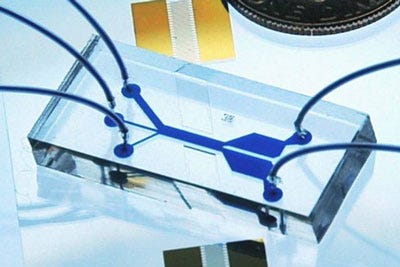September 3, 2014
Researchers from the Massachusetts Institute of Technology (MIT), Pennsylvania State University and Carnegie Mellon University have devised a "gentler" way to identify cancer cells, using sound waves, according to a statement by MIT.
Their dime-sized device could be used to detect the extremely rare tumor cells that circulate in cancer patients' blood, helping doctors predict whether a tumor is going to spread.
|
The technology uses acoustic transducers to sort cells as they move through the channel. Image from MIT. |
Existing cell-sorting technologies require tagging the cells with chemicals or exposing them to stronger mechanical forces that may damage them, the university said.
The researchers' paper appeared in last week's Proceedings of the National Academy of Sciences. They have filed for a patent on the device, whose technology they have demonstrated can be used to separate rare circulating cancer cells from white blood cells.
Scientists have previously built microfluidic devices with two acoustic transducers, which produce sound waves on either side of a microchannel. The two waves meet to combine a standing wave, which remains in a constant position. This wave produces a line of low pressure called a pressure node that runs parallel to the direction of cell flow. The pressure node pushes cells to the side of the channel, with the distance depending on the cells' size and other properties, such as compressibility.
With only one pressure node, cells can be pushed aside only short distances.
Penn State researchers announced in 2012 in the journal Lab on a Chip that they had engineered a device to separate cells with sound waves, paving the way for smaller, more efficient, and less expensive analytic devices.
The new device tilts the sound waves so they run across the microchannel at an angle, meaning that each cell encounters several pressure nodes as it flows through the channel. Each time it runs into a node, the pressure guides the cell a little further off center, making it easier to capture cells of different sizes by the time they reach the end of the channel, the MIT statement said.
Taher Saif, a professor of mechanical science and engineering at the University of Illinois at Urbana-Champaign, said the use of the angled sound waves "is just enough to make cells of different sizes and properties separate from each other without causing any damage or harm to them." Saif was not involved in this work.
They also developed a computer simulation to predict a cell's trajectory through the channel based on its size, density, and compressibility, as well as the angle of the sound waves, allowing them to customize the device to separate different types of cells.
To test whether the device could detect circulating tumor cells, the researchers tried to separate breast cancer cells known as MCF-7 cells from white blood cells. The MCF-7 cells are 20 microns in diameter, versus 12 microns for the white blood cells. They also differ in density and compressibility.
The device successfully recovered about 71 percent of the cancer cells. The researchers plan to test it with cancer patients' blood samples from to see how well it can detect circulating tumor cells in clinical settings. Such cells are very rare: A 1-milliliter sample of blood may contain only a few tumor cells.
"If you can detect these rare circulating tumor cells, it's a good way to study cancer biology and diagnose whether the primary cancer has moved to a new site to generate metastatic tumors," said Ming Dao, a principal research scientist in MIT's Department of Materials Science and Engineering, and one of the senior authors of the paper.
The research was funded by the National Institutes of Health and the National Science Foundation.
Refresh your medical device industry knowledge at MEDevice San Diego, September 10-11, 2014. |
Nancy Crotti is a contributor to Qmed and MPMN.
Like what you're reading? Subscribe to our daily e-newsletter.
About the Author(s)
You May Also Like



